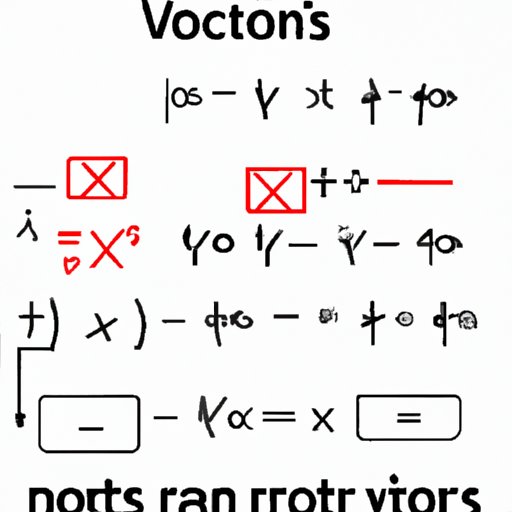
Introduction
Multiplication of square roots can be a challenging topic for many people. It involves dealing with radicals, which can be intimidating for some students. However, with practice and a clear understanding of the basics, anyone can master this mathematical concept. This article is designed to provide a step-by-step guide to multiplying square roots, as well as tips and tricks for simplifying the process.
Mastering the Basics: A Step-by-Step Guide to Multiplying Square Roots
The first step to understanding how to multiply square roots is to know what they are. A square root is a number that, when multiplied by itself, gives the number under the radical sign. For example, the square root of 25 is 5, because 5 multiplied by 5 equals 25.
To multiply two square roots, you simply multiply the numbers under the radical sign and then simplify the result. Here’s an example: √6 × √3 = √18. To simplify this, you need to factor out any perfect square factors from the number under the radical. In this case, 18 can be factored into 2 × 9, which is equal to 2 × 3^2. The 3^2 can be taken out from under the radical and simplified to 3. Therefore, the final answer is √18 = 3√2.
It’s important to note that when multiplying square roots, you can often rearrange or group terms to make the multiplication easier. For example, √2 × √6 = √12, which can be simplified to 2√3. This is because 12 can be factored into 2 × 6, and the 6 can be simplified to √2. Therefore, the final answer is 2√3.
Unlocking the Mystery: How to Multiply Square Roots Without the Hassle
One way to simplify the process of multiplying square roots is to use the concept of conjugates. A conjugate is formed by changing the sign between two terms. For example, the conjugate of √2 + √3 is √2 – √3.
When you multiply a square root by its conjugate, the result is a difference of squares. For example, (√3 + √2) × (√3 – √2) = 3 – 2 = 1. This method is useful when you have square roots that contain different numbers, like √5 and √3.
Here’s an example of how to use conjugates to simplify multiplication of square roots: √7 × (√7 + √2). Start by multiplying the two square roots: √7 × √7 = 7. Next, multiply √7 × √2 to get √14. Add these two results to get 7 + √14. This expression cannot be simplified any further.
Solving the Puzzle: A Comprehensive Guide to Multiplying Square Roots
As you get more comfortable with multiplying square roots, you’ll encounter more complex examples. Here’s an example: (3√5 + 2√3) × (4√5 – √3). To simplify this, you’ll need to use a combination of the distributive property, FOIL, and the conjugate method.
First, distribute the 3√5 to both terms inside the second parenthesis and the 4√5 to both terms inside the first parenthesis. This will give you 12√25 – 3√15 + 8√15 – 2√3.
Next, combine like terms. The terms with √15 can be simplified using the conjugate method to get 5√3. Therefore, the final answer is 12√25 + 5√3 – 2√3.
In-Depth Analysis: Understanding the Process of Multiplying Square Roots
To better understand how to multiply square roots, it’s important to understand the distributive property. The distributive property states that a(b + c) = ab + ac. This applies to multiplying square roots as well.
Here’s an example: √6(√2 + √3). Using the distributive property, you can multiply √6 by √2 and then by √3 to get 2√2 + 3√6. This expression cannot be simplified any further.
When multiplying square roots, it’s important to avoid common mistakes. One common mistake is to multiply the numbers inside the radical separately, like this: √3 × √2 = √6. This is incorrect, because it doesn’t take into account the relationship between the two numbers under the radical. Always multiply the entire term under the radical at once.
The Ultimate Cheat Sheet: Tips and Tricks for Multiplying Square Roots
Here’s a summary of the key points and methods covered in this article:
- When multiplying square roots, multiply the numbers under the radicals and then simplify the result.
- Group terms to make multiplication easier.
- Use conjugates to simplify multiplication.
- Combine like terms and simplify the result.
Here’s a cheat sheet you can use as a quick reference when multiplying square roots:
- To multiply two square roots, multiply the numbers under the radicals and then simplify the result.
- When multiplying square roots, you can often rearrange or group terms to make the multiplication easier.
- Use conjugates to simplify multiplication of square roots.
- The distributive property applies to multiplying square roots as well.
Breaking It Down: Simplifying the Method of Multiplying Square Roots
To simplify the method of multiplying square roots, it’s important to focus on the basics. Always simplify expressions before multiplying them, and use the distributive property to group terms when possible. Remember to factor out perfect square factors to simplify expressions. Practice these techniques with simple examples before moving on to more complex problems.
From Zero to Hero: Quick and Easy Tricks to Multiplying Square Roots
Here are some final tips and tricks to help you master multiplication of square roots:
- Visualize the problem using diagrams or graphs to better understand the relationship between the numbers under the radicals.
- Memorize common perfect squares to make factoring easier.
- Practice, practice, practice! The more you practice, the more comfortable you’ll become with multiplying square roots.
Conclusion
Multiplying square roots may seem daunting at first, but with practice and a clear understanding of the basics, anyone can master this mathematical concept. Use the tips and tricks provided in this article as a guide, and remember to focus on simplifying expressions before multiplying them. By following these steps, you’ll be well on your way to becoming a square root multiplication expert.




